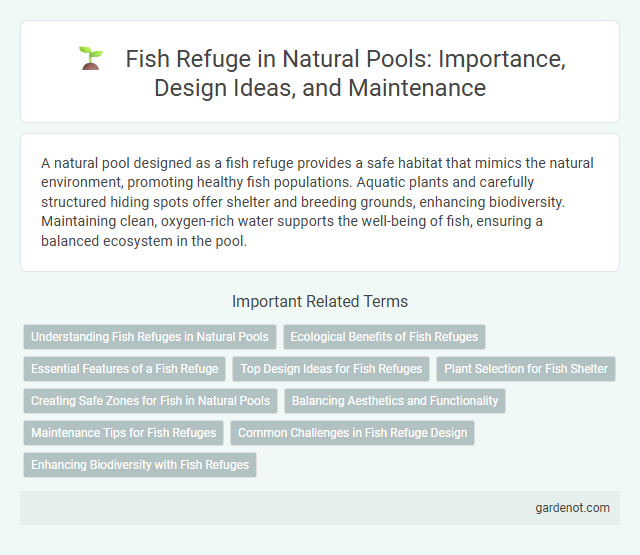A natural pool designed as a fish refuge provides a safe habitat that mimics the natural environment, promoting healthy fish populations. Aquatic plants and carefully structured hiding spots offer shelter and breeding grounds, enhancing biodiversity. Maintaining clean, oxygen-rich water supports the well-being of fish, ensuring a balanced ecosystem in the pool.
Understanding Fish Refuges in Natural Pools
Fish refuges in natural pools provide essential habitats that offer shelter, breeding grounds, and protection from predators, supporting aquatic biodiversity. These refuges maintain ecological balance by preserving diverse fish populations, enhancing water quality through natural filtration processes. Effective design of fish refuges incorporates native vegetation, varying depths, and submerged structures to mimic natural environments and promote fish survival.
Ecological Benefits of Fish Refuges
Fish refuges in natural pools serve as vital habitats that enhance biodiversity by providing shelter and breeding grounds for various aquatic species. These protected areas support ecological balance by promoting the survival of native fish populations, reducing predation pressure, and maintaining water quality through natural filtration processes. Integrating fish refuges into natural pool designs fosters resilience against environmental stressors and contributes to the overall health of freshwater ecosystems.
Essential Features of a Fish Refuge
A fish refuge in a natural pool provides critical shelter and breeding grounds by incorporating dense aquatic vegetation and submerged structures that offer protection from predators. Key features include shaded areas, varying water depths, and water quality parameters such as oxygenation levels that support the health and reproduction of fish species. Effective fish refuges promote biodiversity and ecological balance by maintaining habitats that sustain fish populations throughout seasonal changes.
Top Design Ideas for Fish Refuges
Incorporating submerged structures such as rock piles, aquatic plants, and hollow logs creates effective fish refuges by offering shelter and breeding grounds within natural pools. Designing varying depths and gentle slopes enhances habitat diversity, supporting different fish species' needs throughout life stages. Optimal placement near water vegetation and shaded areas maximizes protection from predators and environmental stressors.
Plant Selection for Fish Shelter
Selecting aquatic plants such as water lilies, hornwort, and waterweeds is essential for creating effective fish refuges in natural pools. These plants provide shelter, breeding grounds, and protection from predators while helping maintain water quality by oxygenating and filtering the water. Proper plant density and diversity optimize habitat conditions, enhancing fish health and biodiversity.
Creating Safe Zones for Fish in Natural Pools
Creating safe zones for fish in natural pools involves designing habitats with ample vegetation and submerged structures to offer shelter from predators and strong currents. Incorporating diverse aquatic plants and rock formations enhances biodiversity by providing spawning grounds and feeding areas. Maintaining water quality through natural filtration supports a thriving fish refuge essential for ecological balance.
Balancing Aesthetics and Functionality
Creating a natural pool with designated fish refuges enhances biodiversity while maintaining water clarity and aesthetic appeal. Strategic placement of submerged vegetation and rock formations provides shelter and breeding grounds for fish, supporting ecological balance without disrupting the pool's visual harmony. Integrating these habitats ensures a seamless blend of functionality and beauty in natural pool design.
Maintenance Tips for Fish Refuges
Maintaining fish refuges in natural pools requires regular monitoring of water quality parameters such as pH, dissolved oxygen, and temperature to ensure a healthy habitat for aquatic life. Removing debris and excess organic matter prevents the buildup of harmful substances that could disrupt fish health. Periodic inspection and reinforcement of refuge structures help sustain shelter and breeding areas, promoting biodiversity and ecological balance within the natural pool ecosystem.
Common Challenges in Fish Refuge Design
Fish refuge design in natural pools faces challenges such as maintaining optimal water quality to support diverse aquatic life, providing adequate shelter that mimics natural habitats, and ensuring stable temperature conditions to prevent stress on fish species. Structural complexity must balance hiding places with open swimming areas to promote healthy fish behavior and biodiversity. Managing predator access while facilitating fish movement remains critical for sustainable refuge ecosystems.
Enhancing Biodiversity with Fish Refuges
Fish refuges within natural pools create safe habitats that promote aquatic biodiversity by offering shelter from predators and breeding grounds. These structures support diverse fish populations, which in turn contribute to a balanced ecosystem and improved water quality. Incorporating vegetation and natural materials in fish refuges enhances habitat complexity, fostering resilience and species richness.
Fish refuge Infographic

 gardenot.com
gardenot.com